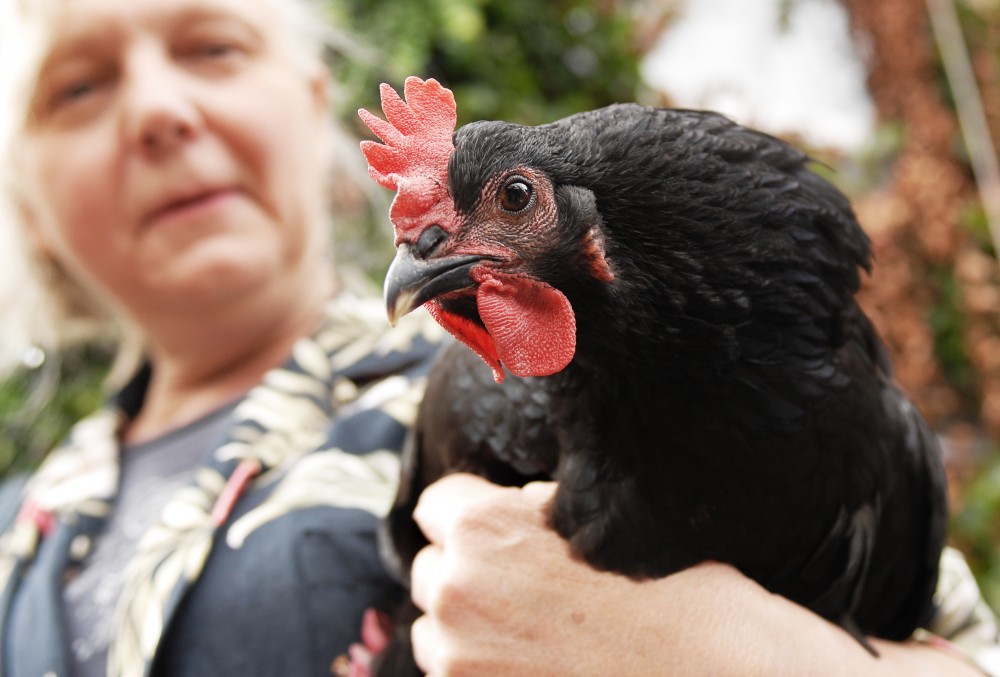Queen Bee watched her fellow chickens scuttle about the yard at Chicken Run Rescue , seemingly unaware that she looked different from her friends who had been there longer. Rescued from a Ramsey, Minn., cockfight bust on Aug. 31 , Queen BeeâÄôs feathers were just beginning to grow back from being plucked out. She was most likely used for breeding. Like dog and cat rescue facilities, Chicken Run Rescue in North Minneapolis nurtures chickens back to health, then puts them up for adoption as pets. As part of Veg Week activities, Compassionate Action for Animals will be taking a group of University students and staff to visit the rescue sanctuary on Sunday in hopes of bringing awareness to the treatment of farm animals. Because animals are exploited in many different industries, advisor and campaign coordinator for CAA Gil Schwartz said, CAA has chosen to focus their awareness efforts on animals raised for food. âÄúIt is where the public can make the most difference,âÄù he said. âÄúEvery day we sit down to eat and make important choices where our food comes from.âÄù Anne McNamara, University staff member and CAA volunteer , organized the trip. She said she hopes it will allow students and staff to make a connection with the chickens they will meet. People often have a preconceived notion that chickens are dumb and donâÄôt have personalities, which isnâÄôt true, McNamara said. âÄúWhen they go have a personal experience with these animals,âÄù she said, âÄúwords just canâÄôt explain how it makes you feel to be with that animal and make that connection.âÄù Mary Britton Clouse, the founder of Chicken Run Rescue , said changing peopleâÄôs perspectives about animals has to start at the bottom of the chain, with chickens. According to an industry trade publication, more than 100 million âÄúspentâÄù hens, who can no longer produce enough eggs, die in slaughterhouses each year. A study by the College of Agriculture and Biological Sciences at South Dakota State University said 98 percent of the egg industryâÄôs hens are in cages on factory farms. Britton Clouse said many of the chickens she cares for are rescued after being confined at a factory farm or from cockfighting busts. Most of the chickens arrive at Chicken Run Rescue after being impounded by Minneapolis Animal Control. They can rehabilitate around 20 chickens at a time. Over the years, Britton Clouse said she has gotten better at piecing together the stories of the birdâÄôs history based on the condition they receive the animal in. Black and red chickens are used mostly in food or egg production. Nancy, a black chicken at Chicken Run Rescue, is a sex-linked chicken, meaning producers could tell whether she was going to be male or female after one day of fertilization, Britton Clouse said. Because roosters are not useful in the egg-laying process, millions of male chickens are killed each year, Britton Clouse said. âÄúPeople have this different mindset about their companion animals and the animals they eat,âÄù she said. The unique nature of what Chicken Run Rescue does is the reason pre-nursing sophomore Marisa Dean said she plans to go on the tour Sunday. âÄúA lot of farm animals, people donâÄôt get emotionally attached to,âÄù she said. âÄúThey view chickens or cows as food. They are animals too, so they should be rescued, too.âÄù Although Britton Clouse and her husband spend $3,000 to $5,000 a year on operating costs, she said itâÄôs worth it when someone makes a connection with a farm animal. âÄúTo me youâÄôve actually got to hold an individual bird and look into their eyes and see they are an individual,âÄù she said.

Image by Tara Sloane
chicken run rescue
Rescued chickens find new home
Published October 2, 2008
0

